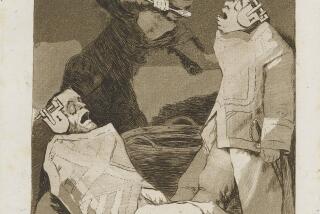The Most Precious Cargo
- Share via
AMSTERDAM — This autumn, in a high-security operation that is shrouded in deepest secrecy, a shipment will depart from a four-story building of oatmeal-colored brick here, bound for Washington, D.C., and then Los Angeles.
The people who work at 7 Paulus Potterstraat are too worried about what might happen to the priceless cargo to reveal exactly when it will be dispatched--or even whether it will go by air or by sea. It’s simply too dangerous, they explain. Vincent van Gogh is going to America. Or more precisely, 70 of the late Dutch painter’s masterpieces--which now hang in Amsterdam’s Van Gogh Museum, the largest repository of his work anywhere--are traveling.
The loan, the biggest in the museum’s history, will constitute the most important survey of the complete sweep of Van Gogh’s career to be seen outside the Netherlands in a generation. The resulting exhibitions, opening Oct. 4 at Washington’s National Gallery and then moving to the Los Angeles County Museum of Art from Jan. 17 through April 4, are expected to be enormously popular.
Meanwhile, back in the boxy, no-frills building on Paulus Potterstraat will be closing for eight months, beginning Sept. 1. For the museum that bears Van Gogh’s name, the international cult around the troubled artist who sold only a single canvas and who ended his life by shooting himself in the chest on July 27, 1890, has gotten too big to handle.
Opened in 1973, the Bauhaus-style gallery of concrete and glass was designed by Dutch architect Gerrit Rietveld to cater to 60,000 visitors a year. Twenty-five years on, the annual crowds have topped 1 million.
The Van Gogh Museum--home to more than 200 of the artist’s lifetime productionof 900 paintings and 500 of his 1,100 drawings--lures throngs of Americans and other foreigners. The nearby Rijksmuseum, home to canvases by Rembrandt, Vermeer and other Dutch masters, can boast more visitors. But the crowds that wait patiently at the Van Gogh’s entrance seem distinctively youngish and enthusiastic.
“He’s one of the artists you hear the most about in high school or college,” said one recent visitor, Janet Cline, 26, an editor from Warrington, Pa., who came with her sister Debbie, 21. “It’s something to stand in front of the actual canvas and say, ‘It was Van Gogh who put his paintbrush here.’ ”
Especially in summer, the most popular tourist season in the Netherlands, the gallery is overwhelmed. Large, slow-moving crowds cluster around well-known paintings, including Van Gogh’s self-portraits and a yellow-and-golden still life of sunflowers in a vase. People troop up and down the single stairway or wait for one of the two elevators.
“You can imagine our problems--a million people a year, and toilet facilities designed for 60,000,” museum spokeswoman Marjelle van Hoorn said.
During the eight months the Van Gogh is closed, the gallery’s climate-control system and lighting will be renovated, along with other modifications. And, to the rear of Rietveld’s building, work is already well underway on a new three-floor annex that will add 22,700 square feet of exhibition space.
The ellipse-shaped, titanium-roofed addition, the brainchild of Japanese architect Kisho Kurokawa, will be used for temporary exhibitions. The core collection, which originally belonged to the Van Gogh family, will remain in the rather nondescript building on Paulus Potterstraat.
While the 70 Van Gogh works are in America, an additional 140, including his dazzling depiction of sunflowers that the museum proudly terms its “icon,” will travel 100 yards to go on temporary display in the South Wing of the neighboring Rijksmuseum. Also slated to be a part of the Rijksmuseum’s special Van Gogh show are “Still Life With Irises,” some of the self-portraits, landscapes of orchards from the southern French city of Arles and the still life of a chair belonging to French artist Paul Gauguin.
“For people who love Van Gogh, there will be a lot to see in Amsterdam still,” Van Hoorn insisted.
Twenty other paintings, including a dozen works by Van Gogh, will be sent on temporary loan to a museum in Enschede in eastern Netherlands.
By next April, all of the Van Gogh’s holdings are supposed to be back at Paulus Potterstraat. The following month, the museum plans to celebrate its expansion and renovation with a temporary exhibition in the new wing devoted to Theo Van Gogh, Vincent’s brother and patron and an art dealer and collector in his own right.
The bulk of the expansion costs are being covered by an $18.7-million donation from a Japanese company, Yasuda Fire & Marine Insurance Ltd., whose involvement with Van Gogh has become very controversial. In 1987, in what was then a record sale for a work of art, Yasuda paid nearly $40 million for another painting of sunflowers attributed to Van Gogh. Since then, some critics have claimed that the work is a fake. Other Van Gogh canvases have sold for even more money--$53.9 million for “Irises” in 1987 (which later was acquired by the Getty Museum), and, most spectacularly, $82.5 million in 1990 for a portrait of the doctor who treated Van Gogh for his mental problems in the last months of his life. No artwork has ever fetched more money.
Although the Van Gogh Museum over the years has removed five of its own holdings from display because of doubts about their authenticity, staff members say there are no doubts whatsoever about the 70 works to be sent temporarily to the United States.
“This selection gives a good idea of what Van Gogh painted in his career--all periods, still lifes, landscapes, portraits,” curator Marije Vellekoop said. Asked how much they might be worth, she smiled and said, “It’s impossible to tell, because we’ll never sell them.”
More to Read
Sign up for The Wild
We’ll help you find the best places to hike, bike and run, as well as the perfect silent spots for meditation and yoga.
You may occasionally receive promotional content from the Los Angeles Times.






